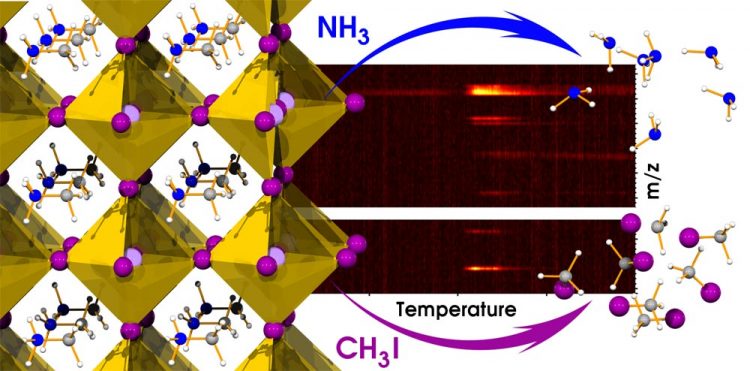New Advances in Solar Cell Technology

MAPbI3 perovskite films decompose to form methyliodide (CH3I) and ammonia (NH3), determined by thermal gravimetric differential thermal analysis and mass spectrometry
Research from the Energy Materials and Surface Sciences Unit at the Okinawa Institute of Science and Technology Graduate University (OIST), led by Prof. Yabing Qi, has focused on using organo-metal halide perovskite films in solar cells. These perovskite films are highly crystalline materials that can be formed by a large number of different chemical combinations and can be deposited at low cost.
Recent publications from Prof. Qi’s lab cover three different areas of innovation in perovskite film research: a novel post annealing treatment to increase perovskite efficiency and stability, a discovery of the decomposition products of a specific perovskite, and a new means of producing perovskites that maintains solar efficiency when scaled up.
In order to be useful as solar cells, perovskite films must be able to harvest solar energy at a high efficiency that is cost-effective, be relatively easy to manufacture, and be able to withstand the outdoor environment over a long period of time. Dr. Yan Jiang in Prof. Qi’s lab has recently published research in Materials Horizons that may help increase the solar efficiency of the organo-metal halide perovskite MAPbI3. He discovered that the use of a methylamine solution during post-annealing led to a decrease in problems associated with grain boundaries.
Grain boundaries manifest as gaps between crystalline domains and can lead to unwanted charge recombination. This is a common occurrence in perovskite films and can reduce their efficiency, making the improvement of grain boundary issues essential to maintain high device performance. Dr. Jiang’s novel post annealing treatment produced solar cells that had fused grain boundaries, reduced charge recombination, and displayed an outstanding conversion efficiency of 18.4%. His treated perovskite films also exhibited exceptional stability and reproducibility, making his method useful for industrial production of solar cells.
One of the biggest disadvantages to the use of perovskites when compared to silicon in solar cells is their relatively short lifespan. In order to create a solar cell that can withstand the outdoor environment over a long period of time, it is crucial to determine the major products of perovskite decomposition. Previous research on MAPbI3 perovskite films led to the conclusion that the gas products of thermal degradation of this material were methylamine (CH3NH2) and hydrogen iodide (HI).
However, exciting new research from Dr. Emilio J. Juarez-Perez, also in Prof. Qi’s lab, published in Energy & Environmental Science, shows that major gas products of degradation are methyliodide (CH3I) and ammonia (NH3) instead. Dr. Juarez-Perez used a combination of thermal gravimetric differential thermal analysis (TG-DTA) and mass spectrometry (MS) to correctly determine both the mass loss and chemical nature of these products. Because the products of decomposition have now been correctly identified, researchers can look for ways to prevent degradation of the material, leading to more stable materials for use in the future.
A pervasive problem in academic research is often the inability to scale up experiments for use in industry. While perovskite films can be made with relative ease on a small scale in the laboratory, they can be difficult to replicate on the large scale needed for mass production. New research from Dr. Matthew Leyden in the Journal of Materials Chemistry A has the potential to make industrial production of perovskites much easier. His work uses chemical vapor deposition, a cost-effective process commonly used in industry, to create large solar cells and modules of FAPbI3 perovskites.
This is one of the first demonstrations of perovskite solar cells and modules fabricated by a method widely employed in industry, making the mass production of perovskite films more feasible. The solar cells and modules produced are significantly larger, e.g., 12 cm2, than those commonly studied in academia, typically <0.3cm2. These solar modules show enhanced thermal stability and relatively high efficiencies, which is impressive as many perovskite solar cells lose efficiency drastically as they are scaled up, making this type of research useful for commercial purposes.
Research from Prof. Qi’s research unit has brought perovskite solar cells one step closer to mass production by providing solutions to problems of efficiency, life-span, and scalability. With more exciting research on the horizon, the unit is bringing the dream of utilizing cost-effective renewable energy resources into reality.
For further information, please contact:
Kaoru Natori
media@oist.jp
Media Contact
More Information:
http://www.oist.jpAll latest news from the category: Power and Electrical Engineering
This topic covers issues related to energy generation, conversion, transportation and consumption and how the industry is addressing the challenge of energy efficiency in general.
innovations-report provides in-depth and informative reports and articles on subjects ranging from wind energy, fuel cell technology, solar energy, geothermal energy, petroleum, gas, nuclear engineering, alternative energy and energy efficiency to fusion, hydrogen and superconductor technologies.
Newest articles

High-energy-density aqueous battery based on halogen multi-electron transfer
Traditional non-aqueous lithium-ion batteries have a high energy density, but their safety is compromised due to the flammable organic electrolytes they utilize. Aqueous batteries use water as the solvent for…

First-ever combined heart pump and pig kidney transplant
…gives new hope to patient with terminal illness. Surgeons at NYU Langone Health performed the first-ever combined mechanical heart pump and gene-edited pig kidney transplant surgery in a 54-year-old woman…

Biophysics: Testing how well biomarkers work
LMU researchers have developed a method to determine how reliably target proteins can be labeled using super-resolution fluorescence microscopy. Modern microscopy techniques make it possible to examine the inner workings…





















